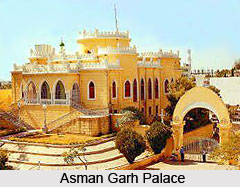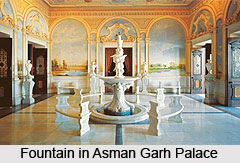 History of Asman Garh Palace defines the medieval history of feudal lords of Hyderabad. Asman Garh Palace in Hyderabad of Telangana is a newly formed state in South India. Asman Garh Palace is one of main attractions in Hyderabad. Hyderabad is the city of Nizams and Aman Garh Palace is one of the examples of Islamic and Persian architecture.
History of Asman Garh Palace defines the medieval history of feudal lords of Hyderabad. Asman Garh Palace in Hyderabad of Telangana is a newly formed state in South India. Asman Garh Palace is one of main attractions in Hyderabad. Hyderabad is the city of Nizams and Aman Garh Palace is one of the examples of Islamic and Persian architecture.
Asmangarh Palace is located on a small hill with an attractive view of the surrounding forest. Asmangarh Palace served as a hunting preserve ground for the Nizams of Hyderabad and his courtiers.
The Nizam was so fascinated by this miniature castle that he became a regular visitor. Sir Asman Jah eventually gifted it to the Nizam of Hyderabad.
Asmangarh Palace was designed personally and built by the former Prime Minister of the Princely State of Hyderabad state, Sir Asman Jah in the year 1885 on a hillock for leisure.
 Sir Asman Jah belonged to the Paigah family. He fulfilled his dream of building a home close to the sky. His real name was Mohammed Mazharuddin Khan. He was the grandson of the second Nizam, Sikander Jah Unused for quite sometime, the palace was leased to the Birla Industries after Independence, who located their Archaeological Museum in it. After more than four decades, the Birla Museum moved out and the building is now occupied by St. Joseph`s Public School, a Covent school in Hyderabad.
Sir Asman Jah belonged to the Paigah family. He fulfilled his dream of building a home close to the sky. His real name was Mohammed Mazharuddin Khan. He was the grandson of the second Nizam, Sikander Jah Unused for quite sometime, the palace was leased to the Birla Industries after Independence, who located their Archaeological Museum in it. After more than four decades, the Birla Museum moved out and the building is now occupied by St. Joseph`s Public School, a Covent school in Hyderabad.
Asman Garh Palace is based on Gothic architecture mixed with Persian and Islamic architecture. Asman Garh Palace has a unique shape of a European medieval castle. The granite turrets of Asman Garh Palace and arched windows stand out and signify the erstwhile royal glory of British times.
A granite structure in Gothic style of Asman Garh Palace, the compact building is too small to technically qualify as a palace. But the beauty of Asman Garh Palace makes the position as a palace. Its claim as a palace is however justified by its architectural style and lofty location on a high plinth. The entrance of Asman Garh Palace is approached by a pair of simple symmetrical staircases which lead up to a verandah with painted arches springing from slender Corinthian columns. The painted arch of Asman Garh Palace is repeated in the window openings. The multi-level terraced roof is topped with castellated battlements, which form the parapet and arête most noticeable of its architectural elements.
When the Nizam Mir Osman Ali Khan inherited Asman Garh Palace he added a unique arched gateway in the shape of the Royal Dastar, which is the turban-like headgear, a part of Hyderabad court dress and a symbol of this Princely State of India.



















